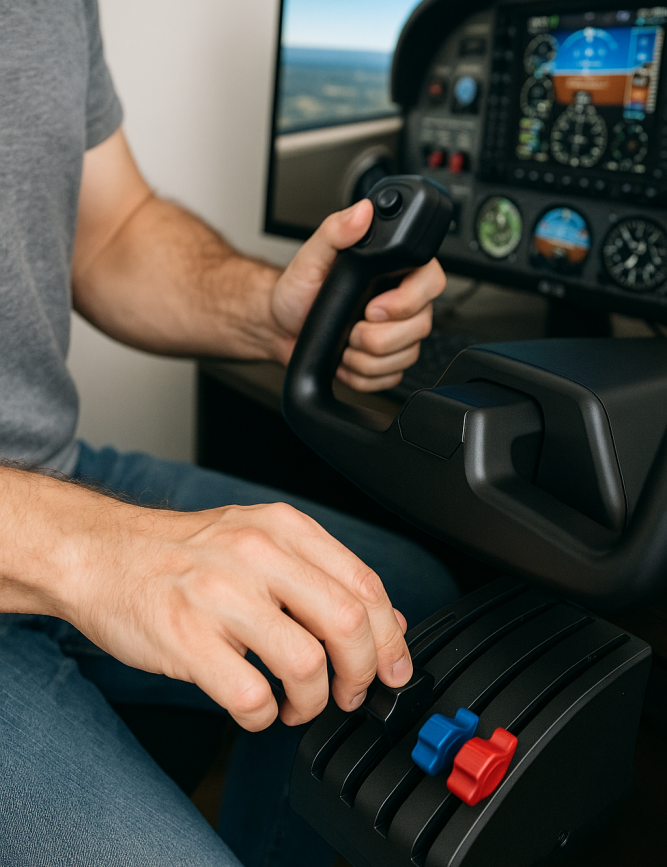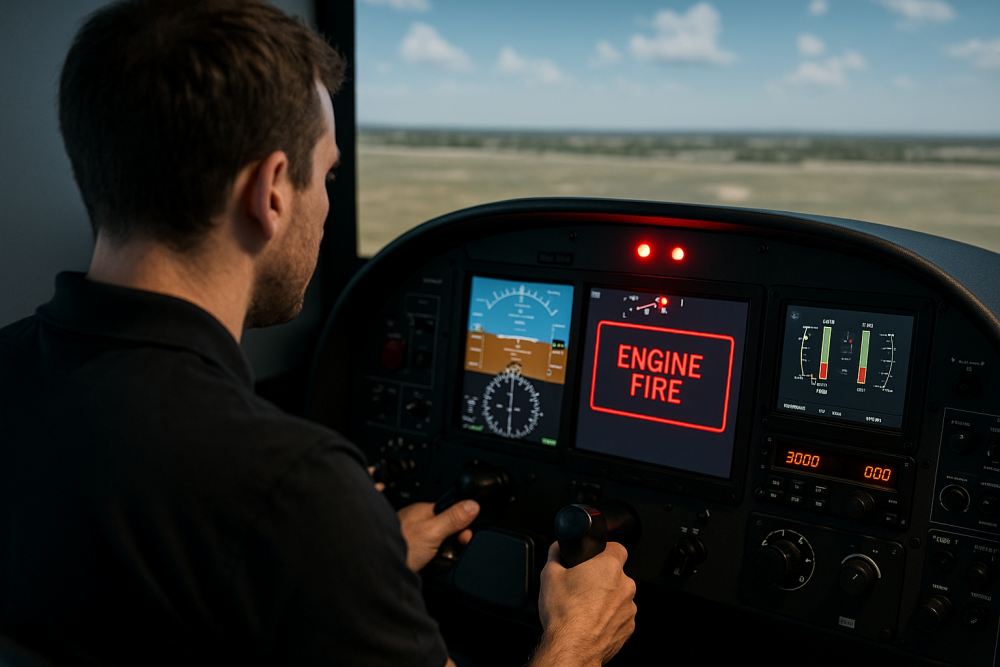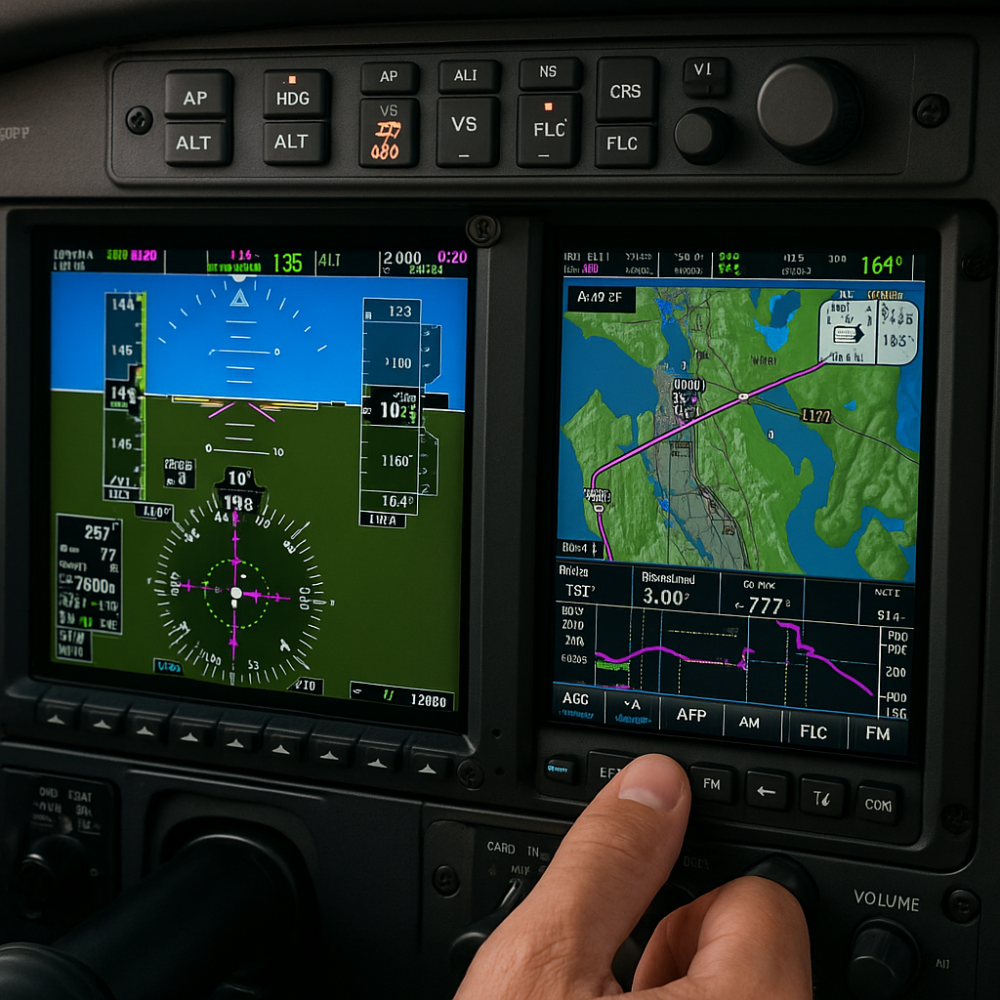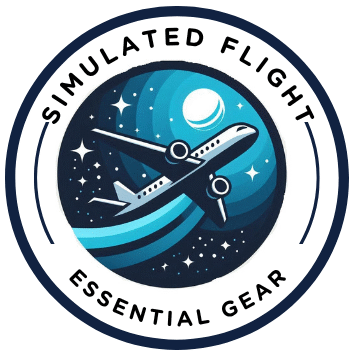Last updated on September 5th, 2025 at 11:22 pm

Nailing those cockpit procedures isn’t easy, especially when you’re just starting out. That’s where flight sims really shine — they’re the secret weapon in a pilot’s toolkit. You can run through checklists, practice those routine flows, and get a feel for how everything fits together in the cockpit. If you’re new to this, check out Getting Started With Flight Simulation: A Step-by-Step Guide for a solid foundation.
Students just starting their aviation journey and even seasoned pilots who might not have flown in a bit find simulators invaluable. They offer a controlled space to repeat those procedures without the distraction or pressure of real flight, helping to embed crucial habits. It’s like having a cheat sheet — one you’ve practiced so many times, you stop needing it. And honestly, getting sharp on these skills before heading back to real flying? Always a smart move.
Building Muscle Memory with Physical Gear

When you’re sitting in front of a simulator with all the bells and whistles, it’s as close as you can get to the real thing. Using a throttle quadrant, control yokes, pedals, and other gear like those featured in my guide to essential hardware upgrades trains your hands to know exactly what to do without thinking. It’s like your brain kicks back and lets your hands take over, which is exactly what you need in a high-pressure situation.
Having that “reach for the flap lever” reaction already built in is a lifesaver. That muscle memory kicks in when it counts. You’ll find yourself reaching for controls instinctively — which frees up your brain to focus on the bigger picture, like staying ahead of the aircraft or managing a busy airspace.
And it’s more than just about your hands. The physical repetition helps sync your actions with your thoughts, enhancing coordination between mind and body. This isn’t just some minor perk, it’s a core part of how simulators give you the upper hand when you transition to flying for real.
Practicing Emergencies in a Safe Environment

Ever wondered how pilots manage when things don’t go as planned? In simulators, you can live through potential nightmare scenarios like engine failures or instrument malfunctions – check out this instrument failure simulation guide to see how it’s handled— all without leaving the ground. This safe setup lets you practice, fail, and master these situations without any real-world risk. I also explore this idea in Building Confidence: Your First Virtual Takeoff and Landing.
Running these drills in a simulator means you get to experience critical scenarios repeatedly until it feels like just another day at the office. It’s about developing a calculated calm rather than panic when the unexpected happens.
That kind of practice builds real confidence. When you’ve worked through these emergency drills in sim over and over, facing them in real life doesn’t feel quite as intimidating — because your instincts are already trained. Plus, when you hit the skies again, you’re armed with a toolkit of practiced responses, ensuring safety and peace of mind for you and your passengers.
Perfecting IFR and Avionics Familiarity

Taking your flying game to the next level means mastering those long IFR sessions and getting cozy with all the fancy avionics gear. Simulators make this part of training way less stressful, and in turn, way more effective.
Instead of worrying about air traffic control nudging you every few minutes, you get to focus purely on nailing those tricky approaches, holds, and en-route diversions. Having all this under your belt means you’re prepared for whatever the skies throw at you.
And then there’s the whole avionics thing. Systems like the Garmin G1000, or the in-depth Flight Management Computers (FMC) in airliners, can be a total headache at first. Simulators are awesome for this because you can mess up, rewind, and try again If you’re diving into advanced navigation tools, check out Exploring Advanced Avionics for Seasoned Sim Users and no stress, no fuel bill, and no ATC side-eye.
It’s pretty sweet knowing you can repeat these drills as much as you need, weather or not. That kind of freedom in training builds not only skill but confidence, and that’s a huge win when you’re at 30,000 feet in the clouds.
Simulators: A Cost-Effective and Flexible Training Solution
Getting solid hours in a cockpit doesn’t always mean having to be in the air. Simulators are a game-changer when it comes to both flexibility and budget.
Flight schools have caught on to this big time. They use FAA-certified simulators for serious training hours that you can actually log. It cuts costs for students and schools alike, making it a practical option for extended learning without straining your wallet.
The beauty of simulators is the anytime, anywhere access. Got a rainy day or airport closure? No big deal. Your home setup is ready for you, keeping those skills sharp and fresh all year round. To build a cost-friendly rig, check out Building a DIY Home Cockpit on a Budget.
And when you’re gearing up for advanced stuff like airline simulator training or type ratings sessions, the practice you’ve put in at home with high-quality add-ons pays off. You’ll feel ready and at ease transitioning to the complexity of airline-level training programs, making each flight session a confidence booster.
✈️ Final Thoughts
At the end of the day, flight simulators are more than just a hobby tool — they’re a training powerhouse. Whether you’re a student trying to memorize flows or a licensed pilot brushing up on procedures after some time off, sims give you a safe, affordable, and repeatable way to stay sharp.
You don’t need a full-motion rig or a commercial-grade cockpit to make it count. Even a solid flight sim joystick, a checklist, and a little time each week can help you build habits that transfer straight into the real world. The more familiar you get with your sim gear and procedures, the more second nature everything becomes when you’re up in the actual skies.
So whether you’re flying for fun, working toward your license, or prepping for an airline interview — keep at it. Every session adds up, and with the right tools and mindset, your simulator can be one of the best copilots you’ve got.

My dad loves airplanes; he’s a pilot but as a hobby-Lol but true. He built his own 2 person open airplane. He even bought me a book of: Amelia Heart” or something like that-the first female pilot. He grew up watching his dad fly-He was in World War Two-That far back. I remember he’d tell me that anyone who knew how to play video games would survive flying one in an emergency of a turbulence.
Reading this, I wonder how they trained pilots to fly planes in the old days before all this technology was invented. I am sure it must have been quite stressful going on a real flight without the experience using the controls. The invention of flight simulators have made everything so much safer for all, and pilots can learn in a far less stressful way how to use all the controls that are in a real airplane.
Absolutely, Michel — you’re spot on. Back in the day, pilot training relied heavily on actual flight time, classroom instruction, and procedural drills using basic mockups or static trainers. It was intense, expensive, and came with higher risk. The introduction of flight simulators truly revolutionized aviation training — not only making it safer and more cost-effective but also allowing pilots to build muscle memory and confidence before ever stepping into a real cockpit. It really changed everything!